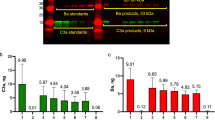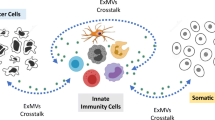Abstract
Background
We have previously shown that the membrane attack complex (MAC) of complement stimulates cell proliferation and that insertion of homologous MAC into the membranes of endothelial cells results in the release of potent mitogens, including basic fibroblast growth factor (bFGF). The mechanism of secretion of bFGF and other polypeptides devoid of signal peptides, such as interleukin 1 (IL-1) is still an open problem in cell biology. We have hypothesized that the homologous MAC pore itself could constitute a transient route for the diffusion of biologically active macromolecules in and out of the target cells.
Materials and Methods
Human red blood cell ghosts and artificial lipid vesicles were loaded with labeled growth factors, cytokines and IgG, and exposed to homologous MAC. The release of the 125I-macromolecules was followed as a function of time. The incorporation of labeled polypeptides and fluorescent dextran (MW: 10,000) was measured in MAC-impacted human red blood cells and human umbilical endothelial cells (HUVEC), respectively.
Results
Homologous MAC insertion into HUVEC resulted in the massive uptake of 10-kD dextran and induced the release of bFGF, in the absence of any measurable lysis. Red blood cell ghosts preloaded with bFGF, IL-1β, and the α-chain of interferon-γ (IFN-γ) released the polypeptides upon MAC insertion, but they did not release preloaded IgG. MAC-impacted ghosts took up radioactive IFN-γ from the extracellular medium. Vesicles loaded with IL-1 released the polypeptide when exposed to MAC.
Conclusions
The homologous MAC pore in its nonlytic form allows for the export of cytosolic proteins devoid of signal peptides that are not secreted through the classical endoplasmic reticulum/Golgi exocytotic pathways. Our results suggest that the release, and perhaps the uptake, of biologically active macromolecules through the homologous MAC pore is a novel biological function of the complement system in mammals.






Similar content being viewed by others
References
Muesch A, Hartmann E, Rohde K, Rubartelli A, Sitia R, Rapoport TA. (1990) A novel pathway for secretory proteins. TIBS 15: 86–88.
Barondes SH, Cooper DNW. (1990) Evidence for export of a muscle lectin from cytosol to extracellular matrix and for a novel secretory mechanism. J. Cell Biol. 10: 1681–1691.
McNeil PL, Muthukrishanan L, Warder E, D’Amore PA. (1989) Growth factors are released by mechanically wounded endothelial cells. J. Cell Biol. 109: 811–822.
Morgan BP. (1990) Complement: Clinical Aspects and Relevance to Disease. Academic Press, London.
Bhakdi S, Tranum-Jensen J. (1991) Complement lysis: A hole is a hole. Immunol. Today 12: 318–320.
Liszewski MK, Farries TC, Lublin, DM, Rooney IA, Atkinson JP. (1996) Control of the Complement System. Adv. Immunol. 61: 201–283.
Lublin DM, Atkinson JP. (1989) Decay-accelerating factor, biochemistry, molecular biology and function. Annu. Rev. Immunol. 7: 35–58.
Davies A, Simmons L, Hale G, et al. (1989) CD59, an Ly-6-like protein expressed in human lymphoid cells, regulates the action of the complement membrane attack complex on homologous cells. J. Exp. Med. 170: 637–654.
Lachmann PJ. (1991) The control of Homologous Lysis. Immunol. Today 12: 312–315.
Giavedoni EB, Chow YM, Dalmasso AP. (1979) The functional size of the primary complement lesion in resealed erythrocyte membrane ghosts. J. Immunol. 122: 240–244.
Ramm LE, Mayer MM. (1980) Life-span and size of the trans-membrane channel formed by large doses of complement. J. Immunol. 124: 2281–2287.
Malinski J, Nelsestuen G. (1989) Membrane permeability to macromolecules mediated by the membrane attack complex. Biochemistry 28: 61–70.
Benzaquen LR, Nicholson-Weller A, Halperin JA. (1994) Terminal complement proteins C5b-9 release basic fibroblast growth factor and platelet-derived growth factor from endothelial cells. J. Exp. Med. 179: 985–992.
Halperin JA, Taratuska A, Nicholson-Weller A. (1993) Terminal complement complex C5b-90 stimulates mitogenesis in 3T3 cells. J. Clin. Invest. 91: 1974–1978.
Bjerrum PJ. (1979) Hemoglobin-depleted human erythrocyte ghosts: characterization of morphology and transport functions. J. Membr. Biol. 48: 43–67.
MacDonald RC, MacDonald RI, Menco BPM, Takeshita K, Subbarao NK, Hu L-R. (1991) Small-volume extrusion apparatus for preparation of large, unilamellar vesicles. Biochim. Biophys. Acta 1061: 297–303.
Halperin JA, Nicholson-Weller A, Brugnara C, Tosteson DC. (1988) Complement induces a transient increase in membrane permeability in unlysed erythrocytes. J. Clin. Invest. 82: 594–600.
Jatinder C, Joist JH, Webster R. (1987) Loss of 51chromium, lactate dehydrogenase, and 111indium as indicators of endothelial cell injury. Lab. Invest. 57: 578–584.
Sauer H, Pratsch L, Tschopp J, Bhakdi S, Peters R. (1991) Functional size of complement and perforin pores compared by confocal laser scanning microscopy and fluorescence microphotolysis. Biochim. Biophys. Acta 1063: 137–146.
Ramm LE, Whitlow MB, Mayer MM. (1982) Size of the transmembrane channels produced by complement proteins C5b-8. J. Immunol. 129: 1143–1146.
Zhang J, Cousens LS, Barr PJ, Sprang SR. (1991) Three-dimensional structure of human basic fibroblast growth factor, a structural homolog of interleukin 1β. Proc. Natl. Acad. Sci. U.S.A. 88: 3446–3450.
Ealick SE, Cook S, Vijak-Kumar S, et al. (1991) Three-dimensional structure of recombinant human interferon gamma. Science 252: 698–702.
Morgan BP. (1995) Physiology and pathophysiology of complement: Progress and trends. Crit. Rev. Clin. Lab. Sci. 32: 265–298.
Cybulsky AV, Monge JC, Papillon J, McTavish AJ. (1995) Complement C5b-9 activates cytosolic phospholipase A2 in glomerular epithelial cells. Am. J. Physiol. 269: F739–F749.
Morgan BP, Luzio JP, Campbell AK. (1986) Intracellular Ca++ in complement membrane attack. Cell Calcium 7: 399–411.
Morgan BP. (1989) Complement membrane attack on nucleated cells: Resistance, recovery and non-lethal effects. Biochem. J. 264: 1–14.
Baldwin III WM, Pruitt SK, Brauer RB, Daha MR, Sanfilippo F. (1995) Complement in organ transplantation. Transplantation 59: 797–808.
Rosen RD. (1993) Complement activation in cardiac disease. In: Curtis MJ (ed). Immunopharmacology of the Heart. Academic Press, London, pp. 75–86.
Stahl GL, Reenstra WR, Frendl G. (1995) Complement-mediated loss of endothelium-dependent relaxation of porcine coronary arteries. Role of the terminal membrane attack complex. Circ. Res. 76: 575–583.
Falk RJ, Sisson SP, Dalmasso AP, Kim Y, Michael AF, Vernier RL. (1987) Ultrastructural localization of the membrane attack complex of complement in human renal tissues. Am. J. Kidney Dis. 9: 121–128.
Torzewski J, Oldroyd R, Lachmann P, Fitzsimmons C, Proudfoot D, Bowyer D. (1996) Complement-induced release of monocyte chemotactic protein-1 from human smooth muscle cells. A possible initiating event in atherosclerotic lesion formation. Arterioscler. Thromb. Vasc. Biol. 16: 673–677.
Sauer H, Pratsch L, Fritzsch G, Bhakdi S, Peters R. (1991) Complement pore genesis observed in erythrocyte membranes by fluorescence microscopic single-channel recording. Biochem. J. 276: 395–399.
Simone CB, Henkart P. (1982) Inhibition of marker influx into complement-treated resealed erythrocyte ghosts by anti-C5. J. Immunol. 128: 1168–1175.
Sims PJ, Lauf PK. (1978) Steady-state analysis of tracer exchange across the C5b-9 complement lesion in a biological membrane. Proc. Natl. Acad. Sci. U.S.A. 75: 5669–5673.
Michaelis DW, Abramovitz AS, Hammer CH, Mayer MM. (1976) Increased ion permeability of planar lipid bilayer membranes after treatment with the C5b-9 cytolytic attack mechanism of complement. Proc. Natl. Acad. Sci. U.S.A. 73: 2852–2856.
Carney DF, Koski CL, Shin ML. (1985) Elimination of terminal complement intermediates from the plasma membrane of nucleated cells: the rate of disappearance differs for cells carrying C5b-7 or C5b-8 a mixture of C5b-8 with a limited number of C5b-9. J. Biol. Chem. 134: 1804–1809.
Acknowledgments
The authors are grateful to Dr. Daniel C. Tosteson for insightful comments on the manuscript, to Dr. T. W. Smith for continuous and enthusiastic support, and to Dr. M. A. Gimbrone, Jr., for kindly providing the HUVEC.
Author information
Authors and Affiliations
Rights and permissions
About this article
Cite this article
Acosta, J.A., Benzaquen, L.R., Goldstein, D.J. et al. The Transient Pore Formed by Homologous Terminal Complement Complexes Functions as a Bidirectional Route for the Transport of Autocrine and Paracrine Signals across Human Cell Membranes. Mol Med 2, 755–765 (1996). https://doi.org/10.1007/BF03401659
Accepted:
Published:
Issue Date:
DOI: https://doi.org/10.1007/BF03401659




